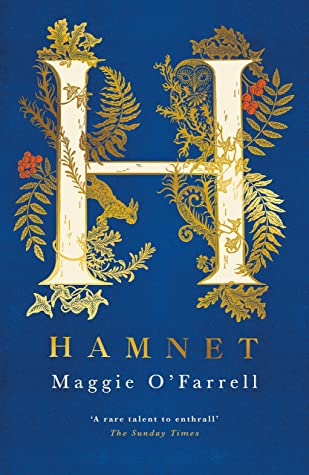
The Blurb (from Goodreads):
Drawing on Maggie O'Farrell's long-term fascination with the little-known story behind Shakespeare's most enigmatic play, HAMNET is a luminous portrait of a marriage, at its heart the loss of a beloved child.
Warwickshire in the 1580s. Agnes is a woman as feared as she is sought after for her unusual gifts. She settles with her husband in Henley street, Stratford, and has three children: a daughter, Susanna, and then twins, Hamnet and Judith. The boy, Hamnet, dies in 1596, aged eleven. Four years or so later, the husband writes a play called Hamlet.
Award-winning author Maggie O'Farrell's new novel breathes full-blooded life into the story of a loss usually consigned to literary footnotes, and provides an unforgettable vindication of Agnes, a woman intriguingly absent from history.
My Thoughts:
Maggie O’Farrell is a new discovery for me. I read her breathtaking memoir I Am, I Am, I Am last year and bought Hamnet the moment I had finished. It was already on my radar, having won the Women’s Prize last year and having been reviewed so positively by many of my friends.
It tells the story of the death of William Shakespeare’s son Hamnet, and how his loss comes to inform the writing of the play ‘Hamlet’. As Maggie O’Farrell notes in her epigraph, in Shakespearean times the names ‘Hamnet’ and ‘Hamlet’ were the same. Although the book is named after the eleven-year-old boy who dies, the narrative focuses mostly on the story of his mother Agnes (the famous Anne Hathaway of the thatched cottage and second-best bed). She is a wild spirit, a witch, a woman of the woods and the fields, barely able to scratch her name. Her grief at the loss of her son is one of the most heartrendingly true depictions I’ve read:
What is given may be taken away, at any time. Cruelty and devastation wait for you around corners, inside coffers, behind doors: they can leap out at you at any time, like a thief or brigand. The trick is never to let down your guard. Never think you are safe. Never take for granted that your children's hearts beat, that they sup milk, that they draw breath, that they walk and speak and smile and argue and play. Never for a moment forget they may be gone, snatched from you, in the blink of an eye, borne away from you like thistledown.
Maggie O’Farrell writes beautifully, but what I love most about this book is the boldness of her artistic vision. She uses the device of the omniscient device brilliantly, sliding in and out of heads and points-of-view with utter confidence. One of my favourite vignettes is the way she follows the journey of the plague bacillus in the body of a flea from a monkey’s fur to the glass beads that Hamnet’s twin sister Judith fingers with such excitement. She also chooses not to name William Shakespeare once. He is the Latin tutor, the husband, the father, the player. He is just a man, a man who makes mistakes, who is unfaithful, who is full of doubts, a man who was not there when his son died. Somehow, the not naming of him is very humanising. It also foregrounds Agnes’s story – the shadowy wife, the silent woman – in this book, she steps forward to the centre of the stage, stands under the spotlight, and speaks out, telling her own story.
Hamnet also has one of the most perfect last lines ever written. Just thinking about it gives me chills. A perfectly composed and executed book, this book will be forever in my heart.
You might also like to read my review of A Parcel of Patterns by Jill Paton Walsh:
https://kateforsyth.com.au/what-katie-read/vintage-book-review-a-parcel-of-patterns-by-jill-paton-walsh

